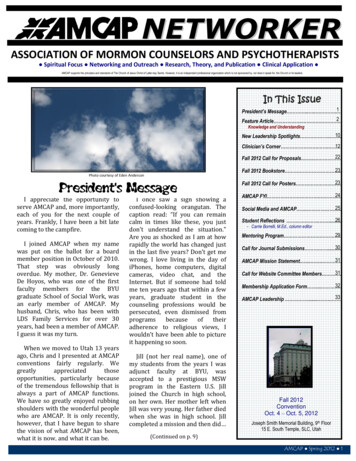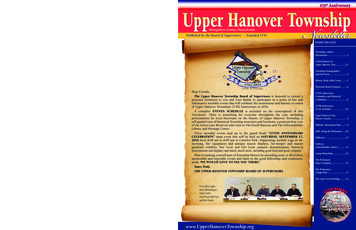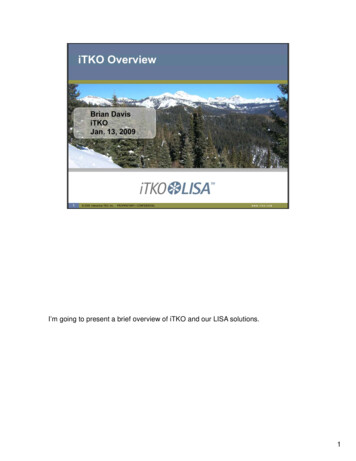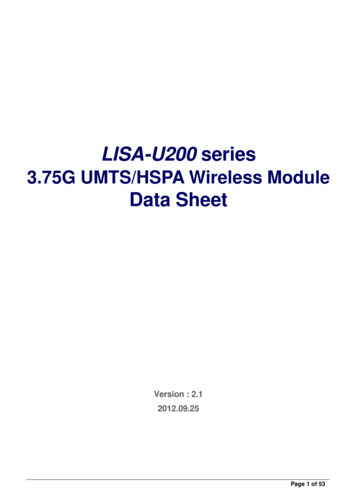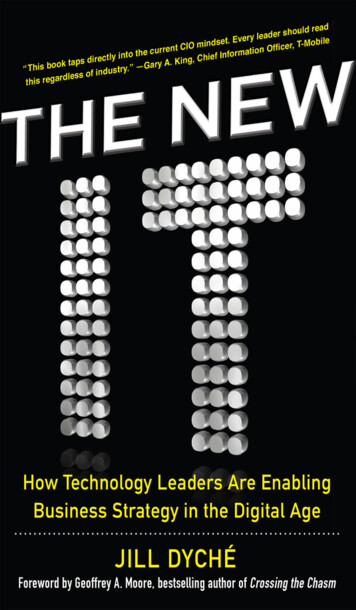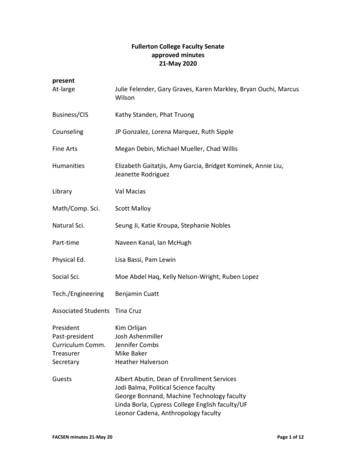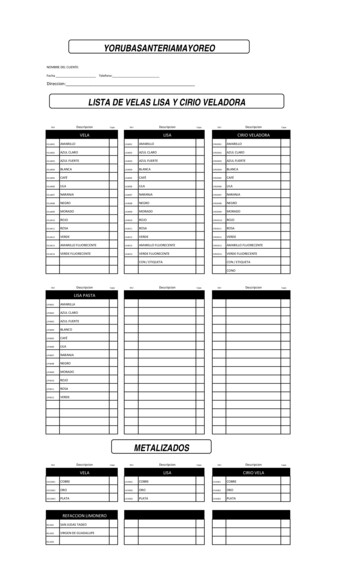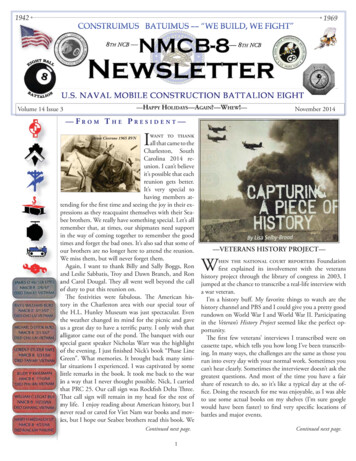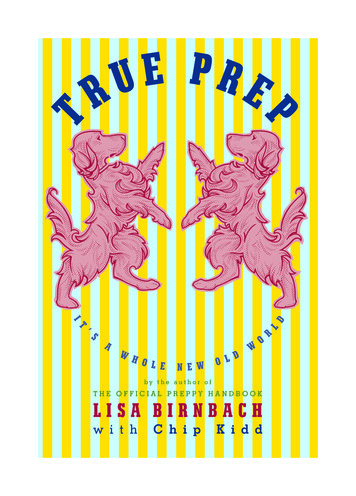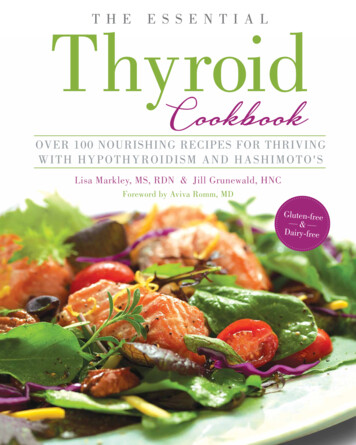
Transcription
Lisa Markley, MS, RDN & Jill Grunewald, HNCForeword by Aviva Romm, MDGluten-free&Dairy-free
The information contained in this book is based on the experience and research of the authors and isbelieved to be accurate, effective, and sound, based on the authors’ research and best judgment. It is notintended to diagnose, treat, cure, or prevent any disease or condition. The information provided hereinshould not be construed as personal medical advice or instruction. No action should be taken solelybased on the contents of this book. Readers who fail to consult appropriate health authorities assumethe risk of any injuries. The authors shall not be held liable or responsible for any misunderstanding ormisuse of the material or for any loss, damage, or injury caused or alleged to be caused directly or indirectly by any treatment, action, or application of any food or food source discussed in this book.The statements in this book have not been evaluated by the U.S. Food and Drug Administration.Published by Blue Wheel Press, LLCPO Box 6755Minneapolis, MN 55406www.thyroidcookbook.comCopyright 2017 Blue Wheel Press, LLCAll rights reserved.No part of this book may be reproduced, stored in a retrieval system, or transmitted byany means, electronic, mechanical, photocopying, recording, or otherwise, without writtenpermission from the copyright holder.The publisher is not responsible for website content not owned by the publisher.Distributed by Greenleaf Book GroupFor ordering information or special discounts for bulk purchases, please contactGreenleaf Book Group at PO Box 91869, Austin, TX 78709, 512.891.6100.Design and composition by Greenleaf Book Group, Courtney Sullivan, and Anthony MaglianoCover design by Greenleaf Book Group, Courtney Sullivan, and Anthony MaglianoPhotographs (food) 2016 Kenny JohnsonFood styling: Anne FisherLibrary of Congress Control Number: 2017933693Print ISBN: 978-09911-7050-0ebook ISBN: 978-0-9911705-1-717 18 19 20 21 22First Edition10 9 8 7 6 5 4 3 2 1
This cookbook is dedicated to the millions who have suffered orare suffering from hypothyroidism and Hashimoto’s thyroiditis.May you be adequately tested, acknowledged with empathy andunderstanding, and compassionately cared for.
ContentsPrefaceForeword xiAcknowledgments and Gratitude A Special Thanks to Melissa Joulwan Introduction Our Story Farm Huggers Both/And: Organic and Sustainable Farming What This Means for You xvxviii157912Part One: Essential Thyroid NutritionAuthored by Jill Grunewald, HNCAbout the Thyroid What Causes Hypothyroidism? We are the 3 Percent: Non-Autoimmune Hypothyroidism The Role of Nutrition in Thyroid Function The Thyroid/Digestion Connection Gluten and Your Thyroid Dairy and Your Thyroid Optimizing Thyroid Hormone Conversion 1721242526272930Why This is Not Another Paleo or AIP Cookbook Spotlight: In Defense of Grains Spotlight: In Defense of Legumes 324041
Low Carb: A Disaster for Those with Hashimoto’s Fiber: The Other Low-Carb Casualty 4447Our Springboard 48Our Methodology 52The Nutritional Heavy Hitters 55Thyroid- and Immune-Supportive Nutrients: How They Work 59Minerals 60Vitamins and Other Nutrients 82The Myth of “Goitrogens” 102A Word About Soy 106The Autoimmune Epidemic The Basics of Mitigating the Autoimmune Response Elimination Provocation Diet Instructions 107110116Conclusion 122Part Two: Essential Thyroid KitchenAuthored by Lisa Markley, MS, RDNPantry Staples and Ingredients 127Non-Gluten Grains 127Gluten-Free Flours 131Legumes/Beans 132Nuts and Seeds 135Plant-Based Milks 140Cooking Oils 141Herbs, Spices, and Flavor Builders 143Natural Sweeteners 146Our “Go-To” Canned and Packaged Foods 148Kitchen Tools and Gadgets viiiThe Essential Thyroid Cookbook153
Part Three: Essential Thyroid RecipesAuthored by Lisa Markley, MS, RDNGuide to the Essential Thyroid Recipes 160Nourishing Beverages 163Breakfasts 181Appetizers and Snacks 201Condiments, Sauces, and Seasonings 217Plant-Based Sides 235Soups and Stews 251Salads 269Main Dishes 285Sweets and Treats 305Part Four: AppendixesAuthored by Jill Grunewald, HNCAppendix A: The Nutritional Springboard for This Cookbook 322Appendix B: Suggested Supplements 323Appendix C: The Important Role of Fats in the Diet 328Appendix D: Eco-Label Reading Guide 330Appendix E: Sustainably-Sourced Seafood 333Appendix F: Affordable Organic and Sustainably-Grown Foodand How to Prioritize 334Appendix G: Increasing Stomach Acid(Hydrochloric Acid Challenge) 337Notes 339Index 352Recipe and Ingredient Index 359About the Authors 370Contents ix
PART ONE:EssentialThyroidNutrition
WHY THIS IS NOTANOTHER PALEOOR AIP COOKBOOKIf you’ve been tuned into the online communities related to thyroidhealth, Hashimoto’s, and other autoimmune conditions, and perhapsread many of the same books and blogs that Lisa and I have, you’ve likelyheard of—and likely tried—a Paleo (aka ancestral) or AIP (autoimmuneprotocol) diet. These diets help to heal the intestinal lining, which is critical for those with any manifestation of autoimmunity.But we’re guessing that at least some of you are beyond the initial diagnostic stage, have walkedthrough immune modulation, and perhaps your Hashimoto’s is managed. Maybe you’ve alreadyembarked on a gut-healing program and diet and have identified your food sensitivities, whichcan cause the immune system to go rogue and create autoimmune antibodies. (The above is anoversimplification of immune modulation and doesn’t necessarily include all of the approachesinvolved.) The point is, perhaps you simply need a cookbook to keep your thyroid and immunesystem supported for years to come.While the entirety of this cookbook can’t be all things to everyone, this cookbook is intendedfor . . . everyone—those just beginning their journey as well as seasoned veterans of autoimmunity management and digestive healing, and anyone in between.Lisa and I have put a lot of thought into making this cookbook as appealing and helpful aspossible. To that end, many of our recipes are Paleo- and AIP-compliant or have Paleo and/or AIP adaptations. But be sure to read this entire chapter to understand why we don’t feel that32
a Paleo/AIP diet is the single solution for everyone, knowing that we fully understand its meritsand effectiveness.We created user-friendly icons to help you easily decipher which recipes will fit your needsat-a-glance and we provided sensible adaptations and modifications, where applicable, to fit thedietary practices of Paleo, AIP, and vegan and also recipes acceptable for an Elimination Provocation diet. In most cases, the adaptation may include simply omitting an ingredient or making asimple ingredient swap to make it compliant. You’ll find our Guide to the Essential Thyroid Recipes,explaining each icon, at the beginning of Part Three.One of the reasons that Lisa and I chose to be outliers is that there are currently more AIPcookbooks out there than you can shake a stick at, and for good reason. And in my work withhundreds of Hashimoto’s clients and students, no one has ever said, “I want to be on the AIP dietfor the rest of my life. I’m fine being on a restricted diet forever.” Many people say that they’ll “dowhat it takes” to get relief and to get their lives back, but getting Hashimoto’s managed doesn’ttake years of dietary restrictions.That level and duration of restriction isn’t necessary. Even many AIP experts and proponentsagree that AIP isn’t a “forever diet.”In short, Lisa and I chose to take the long view with this cookbook—we want it to be a cookbook for the ages. We want it to be what you reach for no matter where you are in your journeyand to feel confident that your thyroid and immune system will be well supported for a lifetime.To further explain my position on Paleo/AIP: Most of the research on the benefits of a Paleo diet was done on men—itmissed half the population. For those at the initial stages of their journey, I see merit in the Paleo and AIPdiets right out the chute—in some circumstances. I explain below. I’m wholeheartedly skeptical of removing whole food groups from the diet.Again, many of the recipes in this cookbook are Paleo- andAIP-compliant, but it wasn’t our intention to make them so—wesimply focused on the most dense thyroid- and immune-supportivenutrients and ingredients.There are varying twists to these diets, but generally, with a Paleodiet, you’re eating what is believed to be the foods that our ancientancestors ate, as in, what they foraged for: meat (grass-based/pastured), fish, vegetables, fruits, nuts, seeds, herbs, spices, eggs, unrefined coconut and olive oil, and animal fats like ghee (butter oil),lard, and tallow. According to some Paleo proponents, fruits are offlimits—others only support eating berries.Foods not allowed include grains (including corn) and legumes“I see meritin the Paleoand AIP dietsright out thechute—in somecircumstances.”Why This is Not Another Paleo or AIP Cookbook33
(including soy), dairy (although some allow grass-fed dairy), sugar, caffeine, and oils derived fromseeds and grains, which can be high in inflammation-promoting Omega-6 fatty acids. Some claimno eggs and others say no starchy vegetables because they can’t be eaten raw.An AIP diet, for those with autoimmune conditions, is similar, but in addition to the aboveexclusions, altogether eschews nuts, seeds, eggs, dairy, nightshade vegetables, and generally, fruit.Our inclusion of non-gluten grains, legumes, nuts, and seeds in this cookbook is thoughtfuland intentional, based on personal and professional experience and a lot of research. I do havesome “restrictions” around grains and legumes, which have remained unchanged, even going backto my pre-Hashimoto’s days (both prior to my diagnosis and in my coaching practice): Largely limit (or eliminate) flour-based products and eat true whole (intact)non-gluten grains, in moderation, because it’s true that a diet heavy in grainscan be inflammatory and lead to weight gain and blood sugar imbalances.(See the chapter, In Defense of Grains and also the chapter, Pantry Staples andIngredients for tips on soaking grains.) Legumes are a great source of plant-based protein, but I recommend not making legumes the sole protein of any meal, unless you can truly handle themwithout digestive distress. Even people who don’t have autoimmune conditions can have a difficult time digesting too many legumes. (See the chapter, InDefense of Legumes and also the chapter, Pantry Staples and Ingredients for tipson enhancing digestibility of legumes.)To provide context for our inclusions, Lisa and I were both diagnosed with Hashimoto’s inearly 2008. At that time, popularity of the Paleo diet hadn’t crested. The AIP diet wasn’t yet onthe scene.As I began my research into low thyroid function and autoimmunity/Hashimoto’s, the importance of healing digestive function became abundantly clear, given that 70-80 percent of our immunesystem is in our digestive tract. I began to sleuth out the dietary triggers that were antagonizing mydigestive lining and contributing to the leaky gut characteristic of autoimmune diseases.In addition to going gluten-free, among other strategies, I did an Elimination Provocationdiet—a version similar to the one I share with my clients today. You can find instructions for thediet in the chapter, Elimination Provocation Diet Instructions and as you’ll see, it’s a temporary diet.It excludes nuts—but not seeds, grains, or legumes, with the exception of peanuts (which aretechnically legumes) and soy. Our recipes that are compatible with an Elimination Provocationdiet are designated with our EP icon.At the onset of my journey, given that the research around how the phytic acids and lectins in grains and legumes (and supposedly nuts and seeds) contribute to leaky gut hadn’t beenpopularized, I didn’t know that I “should” remove these foods from my diet. And within a fewmonths, my Hashimoto’s was managed—without the use of thyroid hormone replacement. My34The Essential Thyroid Cookbook
Hashimoto’s antibodies were negligible, indicating reversal of the condition.Along with my success in healing myautoimmunity came a significant shift inthe thrust of my coaching practice—I beganlargely focusing on helping others withHashimoto’s (and adrenal dysfunction, whichaccompanies Hashimoto’s in nearly every circumstance). Remember, by now, it’s fall of2008—the volume on Paleo and AIP hadn’tyet been turned up. And over those next couple of years, prior to the popularization ofthe AIP diet, the vast majority of my clientshad the same success that I did—plummetingantibodies and alleviation of their hypothyroid/Hashimoto’s symptoms.If I’ve learned anything in the decade I’vebeen a nutrition and hormone coach, it’sthat we’re all bio-individually unique. We allrespond to foods differently—and have different trigger foods. While eggs may be theperfect food for you, they’re an anti-nutrientfor me. This left me in shock and awe whenI did my first Elimination Provocation diet. Ilove eggs and had been eating them regularlyfor breakfast for some time. I had no idea thatthey were contributing to my Hashimoto’s—and alopecia.It’s true that once food sensitivities areidentified and the intestinal lining is healed,you can return to eating the offenders in moderation. (This is not the case with a true foodallergy.) I’m in a bit of a unique situation, aseggs have been shown to continue to exacerbate my alopecia and I’d rather have hair thaneat eggs. But given my digestive healing process, it’s safe for me to eat eggs in moderation.At the same time, for some, simply goinggluten-free gets their Hashimoto’s managed.“Once foodsensitivities areidentified and theintestinal liningis healed, you canreturn to eatingthe offenders inmoderation.”When you consider this, it’s difficult, in myopinion, to rationalize an extreme diet, in allcircumstances, for every single person withautoimmunity.In fact, Laura Schoenfeld, RegisteredDietitian and staff nutritionist for ChrisKresser, a long-time Paleo proponent, autoimmunity expert, and author of The PaleoCure, says, “A strict Autoimmune Paleo Dietisn’t necessary for many people with an autoimmune disease. In fact, there are few people with autoimmune diseases that wouldneed to strictly and permanently avoid allthe foods eliminated from the diet, as noteveryone with autoimmunity is intolerant toall of these foods.” 1 (To be clear, Kresser recommends the exclusion of grains and legumesfor those with autoimmunity.)Although our approaches differ somewhat,even Kresser’s book outlines eliminations, followed by reintroductions/provocations, basedon a flexible Paleo diet. And flexibility is key.Over half of the clients I’ve worked with havetried the Paleo and/or AIP diet. Here are themost frequent comments:Why This is Not Another Paleo or AIP Cookbook35
1. I could do it for a while, but couldn’t hang on—I hit a wall. It was toorestrictive.2. I did it for several months and I actually feel worse. And my antibodies havegone up.3. I wasn’t given any additional instructions on how to heal my gut beyond thediet and didn’t know how long to stay on it.4. I travel for work and this diet is nearly impossible when I’m unable to preparemy own food.I’ve proceeded to coach my clients in the same protocol I adopted—teaching them what I’velearned by making myself a science experiment, during which I ate seeds and moderate amountsof non-gluten grains and legumes, with the exception of peanuts and soy. Again, nuts are excludedfrom the Elimination Provocation diet.There’s the saying, “If it ain’t broke, don’t fix it.”In years of this work, I haven’t found the need to tell the majority of my clients to take onan even more restrictive diet than what’s presented in the Elimination Provocation diet. Mostpeople with Hashimoto’s are already living with fatigue and overwhelm. And while many canembrace significant dietary restrictions with open arms and complete willingness, for many, beingconfronted with an inordinately restrictive diet can be met with a great deal of resistance andstress. It’s my intent to explore how much progress we can make together while adding as littleadditional overwhelm as possible.I like to see what can happen without asking people to resort to—simply meat and vegetables.And more meat and vegetables. I love meat and vegetables. And I would even say that I eat a“Paleo template.” But to rely solely on these foods meal in, meal out, day in, day out can take thepleasure out of one of the most pleasurable acts we humans have—eating.Today, it’s prevailing theory that all people who have an autoimmune disease need to adoptan AIP diet, but I’ve continued to go against the grain (pun intended). I simply don’t believe it’sa one-size-fits-all approach and I guess you could call me a holdout—I’m still not convinced thatit’s required for each and every person with autoimmunity when, for most people, adopting thatstrict of a diet can be stressful. It can get old pretty quickly.Some can thrive on the AIP diet and I’m not here to disregard its merits—that’s not mypoint. But often, a super restrictive diet of any kind is a two-steps-forward-two-steps-back situation. The stress that ensues—at least for some people—isn’t conductive to the healing thatneeds to take place.If there’s another way, I’d like to present it, especially when:36The Essential Thyroid Cookbook
1. There’s enough evidence showing that stress increases antibodies. It’s evensaid to be a trigger for the onset of autoimmune diseases.2 According toautoimmunity expert, Dr. Mark Hyman, “Stress worsens the autoimmuneresponse.”3 (My italics.)2. AIP can require a lot of willpower to adhere to long-term. Willpower is a finiteresource 4—we need to be careful about how we expend our precious energy.Many of my clients exhale audibly when I tell them thatmy approach includes small to moderate amounts of grains,legumes (with the exception of peanuts and soy), and seeds. ThisIn most cases, itsaid, some have been clear that grains and/or legumes give themdoesn’t take monthsdigestive distress. In these cases, I’m of course not going to telland years to tacklethem that they’re fine to consume, but that after their gut-healing protocol, they can likely return to eating these foods (andautoimmunity tothe other foods they’re currently sensitive to), to which I oftenthe ground. Givenhear, “Wow, really?”the right tools forWhile some may be directly affected by grains and legumes,healing, it’s stunningothers can get their autoimmunity managed while continuingto eat small amounts of these foods—as long as other dietarywhat can happentriggers are investigated. In most cases, it doesn’t take monthsin a matter of a fewand years to tackle autoimmunity to the ground. In a healthydays and weeks—nothuman, the intestinal epithelial cells regenerate every four tomonths and years.”five days—one of the fastest rates of reproduction of any tissue5in the body. Given the right tools for healing, it’s stunningwhat can happen in a matter of a few days and weeks—notmonths and years.But it isn’t simply about diet and restriction of certain foods for a period of time. With immunemodulation, there are other factors to consider, including:“ Addressing toxic body burden, including but not limited to toxins in skincare and cosmetics, food and water, home cleaning products, and exposure toendocrine/immune disruptors such as bisphenol-A (BPA), PCB, and heavymetals. The myriad ways in which we become exposed to environmental toxins is beyond the scope of this book, but going organic will significantly reduceyour overall burden. (See The Essential Thyroid Cookbook Lifestyle CompanionGuide for tips on reducing your toxic body burden. You can download it forfree on our website: www.thyroidcookbook.com/companion.)Why This is Not Another Paleo or AIP Cookbook37
Supplementation that’s been shown to “heal and seal” the intestinal lining.(See Appendix B for our supplement recommendations, of which you can alsofind links to on our website: www.thyroidcookbook.com.) Possible bacterial infections such as small intestine bacterial overgrowth(SIBO) or Helicobacter pylori (H. pylori).At the beginning of this chapter, I said that I see some merit in an AIP diet right out of thechute—in some circumstances. In addition to the foods listed in the Elimination Provocationdiet instructions, I recommend the exclusion of grains, legumes, and seeds, in two circumstances:1. When the symptoms of autoimmunity are so painful and distressing as tocause life-altering circumstances. A 49-year old client I worked with had psoriatic arthritis. What had been diagnosed 20 years prior as a fungal infection ofher toenails was, in fact, autoimmune arthritis. (She went 20 years without aproper diagnosis!) The pain had become so intense that she could hardly walk,needed to ride in a cart at the grocery store, and, after finding the right doctorand diagnosis, found out that she had deformity in her joints. In these cases, Ipull out all the stops and suggest an AIP diet.2. When an Elimination Provocation diet hasn’t proven successful. For clientswho were dedicated to the process and don’t find symptom relief and/or findthat their antibodies have been unchanged or have increased, I recommend:a.Eliminating grains, legumes, and seedsb.Getting tested for heavy metal toxicity (this is a good idea anyway)c.In cases of continued and overt digestive distress, getting tested fora bacterial gut infection, like SIBO or H. pylori. (I typically suggestanti-bacterial supplementation anyway, given that many have SIBO,but treating H. pylori is more complicated than treating SIBO.)The exclusion of grains, legumes, and seeds is much easier when the common digestive triggershave already been identified. In other words, once you’ve done an Elimination Provocation dietand know what you can and cannot tolerate, then the foods that you can tolerate are back on thetable. Thus, the elimination of grains, legumes, and seeds isn’t simultaneous to the elimination ofseveral other foods, making the diet—and healing—much more feasible.For example, you do an Elimination Provocation diet and find that of dairy, eggs, citrus, soy,nightshades, shellfish, corn, nuts, and peanuts, only dairy and nightshades prove to be triggerfoods for you. (Gluten should be categorically avoided for everyone with Hashimoto’s. See thechapter, Gluten and Your Thyroid for a full explanation.)38The Essential Thyroid Cookbook
If you do find that grains, legumes, andseeds need to be avoided, you can removethem while eating eggs, citrus, soy, shellfish,corn, nuts, and peanuts and continuing withyour supplemental digestive healing. Youcan then reintroduce them in a similar fashion to the reintroduction instructions in theElimination Provocation diet.Again, every situation is unique. But ifyou’re still unconvinced that healing the gutand managing autoimmunity is possible eating small amounts of grains, legumes, andseeds, I can explain further.In eight years of focusing on autoimmunehypothyroidism in my coaching practice,most of my Hashimoto’s clients have seen adrastic reduction in their thyroid antibodies(and symptoms) and the majority of themhave gotten the condition managed. Additionally, one of my areas of practice is alopecia—autoimmune hair loss. I’ve worked withalopecia clients from around the world andmany have come to me saying, “I’ve triedeverything.” And “everything” often includessome iteration of an Elimination or restricteddiet or autoimmune protocol.With my approach to managing autoimmunity, each and every one of them hasstarted to re-grow hair, including eyelashes,eyebrows, and even a full head of hair afterbeing bald for several years. I don’t expect thatI’ll always have this success rate, certainly.But I do so far, as of this writing, with oneexception. One young girl started re-growinga significant amount of hair, only to lose it allagain. It’s heartbreaking.Early on, based on some of her symptoms, I’d suspected mercury toxicity, whichwas later confirmed by her doctor. As of thiswriting, she’s working to detox heavy metalsfrom her system.As explained, the Paleo and AIP diets differ,but are similar enough that I want to share thisquote from nutrition and health expert, SeanCroxton, who said, “Let’s face it, going 100percent Paleo isn’t for everyone. Even me. Tothe average person, despite its benefits, Paleocan seem intimidating, restrictive, and at timeskinda annoying, to be honest.” 6 Yes, and AIP iseven more restrictive than Paleo.According to respected autoimmunityexpert, Chris Kresser, “The belief that ‘everyone’ will benefit from one particular dietaryapproach—no matter what it is—ignores theimportant differences that determine what isoptimal for each person. These include variations in genes, gene expression, the microbiome, health status, activity levels, geography(e.g. latitude and climate), and more. Whenit comes to diet, there is no one-size-fits-allapproach.”7According to integrative medicine pioneer, Dr. Andrew Weil, “There’s no harm, andsome potential benefit, in trying the Paleodiet, but I believe the diet is too restrictive formost people to stick with long-term. I thinksuccess is more likely for the majority if theyregard it as healthy direction, rather than asa strict set of guidelines from which one cannever deviate.”8Lastly, in his article, “Is There AnythingNew in Nutrition Worth Talking About,”nutritional psychology consultant, MarcDavid, states, “I have watched too manyfriends, students, and clients get hooked ontraditional systems that are old, wise, oftenbrilliant, well thought out—and not always100 percent applicable for humans of this dayWhy This is Not Another Paleo or AIP Cookbook39
and age. In particular, many people embraceAyurveda, Macrobiotics, or the concepts ofthe Paleolithic diet.“Yes, these approaches bring tremendousinsight and practical knowledge that we havelong forgotten. I’ve benefited greatly fromstudying and practicing the principles of thesediets. At the same time, the over-reliance onthese systems often results in an intense fundamentalism, personal and nutritional isolation,and a waste of time in trying to follow in aprecise and unwavering manner—principlesthat may have worked great eons ago, but don’tnecessarily translate fully into our world today.“Every old and ancient system needs someupdating. Macrobiotics is a great example.The principles in this worldview are powerful and far-reaching. The problem is, mostpeople practice a form of macrobiotics thatworks fine if you’re from Japan, but not sowell let’s say, if you’re a white dude fromMississippi. The challenge is, can you be boldand creative enough to take what truly worksfrom these approaches, and toss out whatdoesn’t?” 9 (My italics.)Spotlight: In Defenseof GrainsGluten-containing grains, including wheat(einkorn, durum, faro, graham, kamut, semolina, spelt), barley, rye, and triticale shouldbe avoided for those with Hashimoto’s andfor some, going completely grain-free can behelpful for managing any form of autoimmunity. But Lisa and I don’t believe that whole,gluten-free grains are categorically bad foreveryone, especially after your Hashimoto’s/autoimmunity is managed.40The Essential Thyroid CookbookThe argument against grains is that theycontain the anti-nutrients phytic acid andlectin, along with enzyme-inhibitors thatblock mineral absorption and irritate theintestinal wall, which is clearly what youwant to avoid when on an autoimmunityrecovery program. Yet these anti-nutrientsare also found in vegetables like beets anddark leafy greens, but that doesn’t mean weshouldn’t eat these foods.Grains are naturally high in vitaminsand minerals and the key is to properly prepare them to release these nutrients. It’s onlyrecently—the past century or so—that we’vegotten away from the traditional practices ofleavening/fermentation, soaking, and sprouting (germinating), which “pre-digests” grains.Additionally, Vitamin A inhibits the potentially negative effects of phytic acid. (Formore on Vitamin A, see the Vitamins andOther Nutrients subchapter in the chapter,The Nutritional Heavy Hitters.)When prepared traditionally, grains aremuch easier to digest, we’re able to absorbtheir nutrition, and they help to produce serotonin, a neurotransmitter that brings about asense of comfort, calm, and alertness. (Thepotential for serotonin production is enoughright there to consider whether grains shouldbe avoided.)Additionally, when you consider thatsprouted grains encourage the growth offriendly intestinal bacteria, help to keep thecolon clean, and are high in antioxidants, wehave to ask ourselves if moderate consumption of grains, along with a gut-healing protocol, is really such a bad idea.Addressing the myth that our ancestors onlyate meat and vegetables, globally recognized
leader in natural health and Ayurvedic medicine, Dr. John Douillard, states, “Accordingto the latest anthropological findings, muchof the ‘gathering’ was harvesting grain fromindigenous grasses. This contributed greatlyto the starch that researchers believe made upsome 35 percent of the hunter-gatherer diet.”He continues, “The anti-grain sentiment thatfloods the media today has much to do withthe fact that we have over-eaten grains. Newstudies suggest that we have microbes andspecific enzymes specially designed to breakdown the hard-to-digest gluten protein—when eaten in season and in moderation.”1In sharing Dr. Douillard’s quote, I’m notsuggesting that anyone with Hashimoto’s eatgluten. (See the chapter, Gluten and Your Thyroid for more on the specific thyroid/glutenrelationship.) But I believe we can extrapolatehis thinking about gluten to any grain mean-“When you considerthat sprouted grainsencourage the growthof friendly intestinalbacteria, help to keepthe colon clean, and arehigh in antioxidants, wehave to ask ourselves ifmoderate consumptionof grains, along with agut-heal
This cookbook is dedicated to the millions who have suffered or . embarked on a gut-healing program and diet and have identified your food sensitivities, which . digestive lining and contributing to the leaky gut characteristic of autoimmune diseases. In addition to going gluten-free, amo
